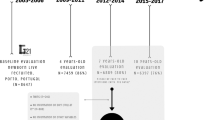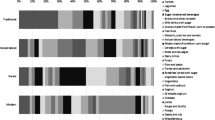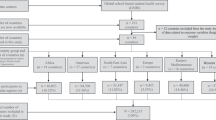Abstract
Background:
The European IDEFICS (Identification and prevention of dietary- and lifestyle-induced health effects in children and infants) study was set up to determine the aetiology of overweight, obesity and related disorders in children, and to develop and evaluate a tailored primary prevention programme.
Objective:
This paper focuses on the aetiological element of the multicentre study, the measures and examinations, sociodemographic characteristics of the study sample and proportions of participation.
Design:
Prospective cohort study with an embedded intervention study that started with a baseline survey in eight countries in 2007–2008.
Subjects and measurements:
Baseline participants of the prospective cohort study were 16 224 children aged 2–9 years. Parents reported sociodemographic, behavioural, medical, nutritional and other lifestyle data for their children and families. Examinations of children included anthropometry, blood pressure, fitness, accelerometry, DNA from saliva and physiological markers in blood and urine. The built environment, sensory taste perception and other mechanisms of children's food choices and consumer behaviour were studied in subgroups.
Results:
Between 1507 and 2567, children with a mean age of 6.0 years and an even sex distribution were recruited from each country. Of them, 82% lived in two-parent families. The distribution of standardised income levels differed by study sample, with low-income groups being strongly represented in Cyprus, Italy and Germany. At least one 24-h dietary recall was obtained for two-thirds of the children. Blood pressure and anthropometry were assessed in more than 90%. A 3-day accelerometry was performed in 46%, motor fitness was assessed in 41%, cardiorespiratory fitness in 35% and ∼11% participated in taste perception tests. The proportion of children donating venous blood, urine and saliva was 57, 86 and 88%, respectively.
Conclusion:
The IDEFICS cohort provides valuable data to investigate the interplay of social, environmental, genetic, physiological and behavioural factors in the development of major diet- and lifestyle-related disorders affecting children at present.
This is a preview of subscription content, access via your institution
Access options
Subscribe to this journal
Receive 12 print issues and online access
$259.00 per year
only $21.58 per issue
Buy this article
- Purchase on Springer Link
- Instant access to full article PDF
Prices may be subject to local taxes which are calculated during checkout




Similar content being viewed by others
References
Flodmark CE, Lissau I, Moreno LA, Pietrobelli A, Widhalm K . New insights into the field of children and adolescents’ obesity: the European perspective. Int J Obes 2004; 28: 1189–1196.
Hedley AA, Ogden CL, Johnson CL, Carroll MD, Curtin LR, Flegal KM . Prevalence of overweight and obesity among US children, adolescents, and adults, 1999–2002. J Am Med Assoc 2004; 291: 2847–2850.
McArthur LH, Holbert D, Peña M . Prevalence of overweight among adolescents from six Latin American cities: a multivariable analysis. Nutr Res 2003; 23: 1391–1402.
Moreno LA, Pigeot I, Ahrens W (eds). Epidemiology of Obesity in Children and Adolescents—Prevalence and Etiology. Springer Publisher: New York, USA, 2011 (http://dx.doi.org/10.1007/978-1-4419-6039-9).
Ogden CL, Carroll MD, Flegal KM . High body mass index for age among US children and adolescents, 2003–2006. J Am Med Assoc 2008; 299: 2401–2405.
Olds TS, Tomkinson GR, Ferrar KE, Maher CA . Trends in the prevalence of childhood overweight and obesity in Australia between 1985 and 2008. Int J Obes 2009; 34: 57–66.
Péneau S, Salanave B, Maillard-Teyssier L, Rolland-Cachera MF, Vergnaud AC, Méjean C et al. Prevalence of overweight in 6- to 15-year-old children in central/western France from 1996 to 2006: trends toward stabilization. Int J Obes 2009; 33: 401–407.
Stamatakis E, Wardle J, Cole TJ . Childhood obesity and overweight prevalence trends in England: evidence for growing socioeconomic disparities. Int J Obes 2009; 34: 41–47.
Lissner L, Sohlström A, Sundblom E, Sjöberg A . Trends in overweight and obesity in Swedish schoolchildren 1999–2005: has the epidemic reached a plateau? Obes Rev 2010; 11: 553–559.
Ahrens W, Moreno LA, Pigeot I . Childhood obesity: prevalence worldwide—synthesis part I. In: Moreno LA, Pigeot I, Ahrens W (eds). Epidemiology of Obesity in Children and Adolescents—Prevalence and Etiology. Springer Publisher, New York, USA, 2011, pp 219–235.
Rodríguez G, Pietrobelli A, Wang Y, Moreno LA . Methodological aspects for childhood and adolescence obesity epidemiology. In: Moreno LA, Pigeot I, Ahrens W (eds). Epidemiology of Obesity in Children and Adolescents—Prevalence and Etiology. Springer Publisher: New York, USA, 2011, pp 21–41.
Ahrens W, Bammann K, De Henauw S, Halford J, Palou A, Pigeot I et al. Understanding and preventing childhood obesity and related disorders—IDEFICS: a European multilevel epidemiological approach. Nutr Metab Cardiovasc Dis 2006; 16: 302–308.
Bammann K, Peplies J, Sjöström M, Lissner L, De Henauw S, Galli C et al. Assessment of diet, physical activity, biological, social and environmental factors in a multi-centre European project on diet- and lifestyle-related disorders in children (IDEFICS). J Public Health 2006; 14: 279–289.
De Henauw S, Verbestel V, Mårild S, Barba G, Bammann K, Eiben G et al. The IDEFICS community-oriented intervention programme: a new model for childhood obesity prevention in Europe? Int J Obes 2011; 35 (Suppl 1): S16–S23.
Suling M, Hebestreit A, Peplies J, Bammann K, Nappo A, Eiben G et al. Design and results of the pretest of the IDEFICS study. Int J Obes 2011; 35 (Suppl 1): S30–S44.
Vereecken CA, Covents M, Sichert-Hellert W, Fernández Alvira JM, Le Donne C, De Henauw S et al. Development and evaluation of a self-administered computerized 24-h dietary recall method for adolescents in Europe. Int J Obes 2008; 32 (Suppl 5): S26–S34.
International Standard Classification of Education (ISCED). UNESCO 1997. http://www.unesco.org/education/information/nfsunesco/doc/isced_1997.htm (accessed April 2010).
Marfell-Jones M, Olds T, Stewart A, Carter L . International Standards for Anthropometric Assessment. International Society for the Advancement of Kinanthropometry: Potchefstroom, South Africa, 2006.
Gwozdz W, Reisch LA, on behalf of the IDEFICS Consortium. Instruments for analysing the influence of advertising on children's food choices. Int J Obes 2011; 35 (Suppl 1): S137–S143.
Stomfai S, Ahrens W, Bammann K, Kovács É, Mårild S, Michels N et al. Intra- and inter-observer reliability in anthropometric measurements in children. Int J Obes 2011; 35 (Suppl 1): S45–S51.
Marangoni F, Colombo C, Galli C . A method for the direct evaluation of the fatty acid status in a drop of blood from a fingertip in humans: applicability to nutritional and epidemiological studies. Anal Biochem 204; 326: 267–272.
Peplies J, Günther K, Bammann K, Fraterman A, Russo P, Veidebaum T et al. Influence of sample collection and preanalytical sample processing on the analyses of biological markers in the European multicentre study IDEFICS. Int J Obes 2011; 35 (Suppl 1): S104–S112.
Committee of Experts on Sports Research EUROFIT. Handbook for the EUROFIT Tests of Physical Fitness, 2nd edn. Council of Europe: Strasburg, France, 1993.
Trimpou P, Bosaeus I, Bengtsson BA, Landin-Wilhelmsen K . High correlation between quantitative ultrasound and DXA during 7 years of follow-up. Eur J Radiol 2010; 73: 360–364.
Ahuja SP, Greenspan SL, Lin Y, Bowen A, Bartels D, Goyal RK . A pilot study of heel ultrasound to screen for low bone mass in children with leukemia. J Pediatr Hematol Oncol 2006; 28: 427–432.
Khaw KT, Reeve J, Luben R, Bingham S, Welch A, Wareham N et al. Prediction of total and hip fracture risk in men and women by quantitative ultrasound of the calcaneus: EPIC-Norfolk prospective population study. Lancet 2004; 363: 197–202.
Cole TJ, Bellizzi MC, Flegal KM, Dietz WH . Establishing a standard definition for child overweight and obesity worldwide: international survey. Brit Med J 2000; 320: 1240–1243.
Molnar D . The prevalence of the metabolic syndrome and type 2 diabetes mellitus in children and adolescents. Int J Obes Relat Metab Disord 2004; 28 (Suppl 3): 70–74.
Weiss R, Dziura J, Burgert TS, Tamborlane WV, Taksali SE, Yeckel CW et al. Obesity and the metabolic syndrome in children and adolescents. N Engl J Med 2004; 350: 2362–2374.
Knof K, Lanfer A, Bildstein MO, Buchecker K, Hilz H, on behalf of the IDEFICS Consortium. Development of a method to measure sensory perception in children at European level. Int J Obes 35 (Suppl 1): S131–S136.
Lanfer A, Hebestreit A, Ahrens W, Krogh V, Sieri S, Lissner L et al. Reproducibility of food consumption frequencies derived from the Children's Eating Habits Questionnaire used in the IDEFICS study. Int J Obes 2011; 35 (Suppl 1): S61–S68.
Herrmann D, Suling M, Reisch L, Siani A, De Bourdeaudhuij I, Maes L et al. Repeatability of maternal report on prenatal, perinatal and early postnatal factors: findings from the IDEFICS parental questionnaire. Int J Obes 2011; 35 (Suppl 1): S52–S60.
Huybrechts I, Börnhorst C, Pala V, Moreno LA, Barba G, Lissner L et al. Evaluation of the Children's Eating Habits Questionnaire used in the IDEFICS study by relating urinary calcium and potassium to milk consumption frequencies among European children. Int J Obes 2011; 35 (Suppl 1): S69–S78.
Bammann K, Sioen I, Huybrechts I, Casajús JA, Vicente-Rodríguez G, Cuthill R et al. The IDEFICS validation study on field methods for assessing physical activity and body composition in children: design and data collection. Int J Obes 2011; 35 (Suppl 1): S79–S87.
Sioen I, Goemare S, Ahrens W, De Henauw S, De Vriendt T, Kaufman J-M et al. The relationship between paediatric calcaneal quantitative ultrasound measurements and dual energy X-ray absorptiometry (DXA) and DXA with laser (DXL) as well as body composition. Int J Obes 2011; 35 (Suppl 1): S125–S130.
Acknowledgements
This study was conducted as part of the IDEFICS study (http://www.idefics.eu). We gratefully acknowledge the financial support of the European Community within the Sixth RTD Framework Programme Contract no. 016181 (FOOD) and the grant support from EU for the IDEFICS study. We are grateful for the support provided by school boards, headmasters and communities. We thank the IDEFICS children and their parents for participating in this extensive examination. LI and LR have received grant support from European Union for the IDEFICS study.
The information in this document reflects the authors’ view and is provided as is.
Author information
Authors and Affiliations
Consortia
Corresponding author
Ethics declarations
Competing interests
The authors declare no conflict of interest.
Additional information
Statement of ethics
We certify that all applicable institutional and governmental regulations pertaining to the ethical use of human volunteers were followed during this research. Approval by the appropriate ethical committees was obtained by each of the eight centres engaged in the fieldwork. Participants were not subjected to any study procedure before both the children and their parents gave their consent for examinations, collection of samples, subsequent analysis and storage of personal data and collected samples. The participating children and their parents could consent to single components of the study while refraining from others.
Rights and permissions
About this article
Cite this article
Ahrens, W., Bammann, K., Siani, A. et al. The IDEFICS cohort: design, characteristics and participation in the baseline survey. Int J Obes 35 (Suppl 1), S3–S15 (2011). https://doi.org/10.1038/ijo.2011.30
Published:
Issue Date:
DOI: https://doi.org/10.1038/ijo.2011.30
Keywords
This article is cited by
-
KLB and NOX4 expression levels as potential blood-based transcriptional biomarkers of physical activity in children
Scientific Reports (2023)
-
Chronic disease outcome metadata from German observational studies – public availability and FAIR principles
Scientific Data (2023)
-
Cardiometabolic risk profile among children with migrant parents and role of parental education: the IDEFICS/I.Family cohort
International Journal of Obesity (2023)
-
Genetic associations vary across the spectrum of fasting serum insulin: results from the European IDEFICS/I.Family children’s cohort
Diabetologia (2023)
-
Longitudinal association of childhood physical activity and physical fitness with physical activity in adolescence: insights from the IDEFICS/I.Family study
International Journal of Behavioral Nutrition and Physical Activity (2022)



